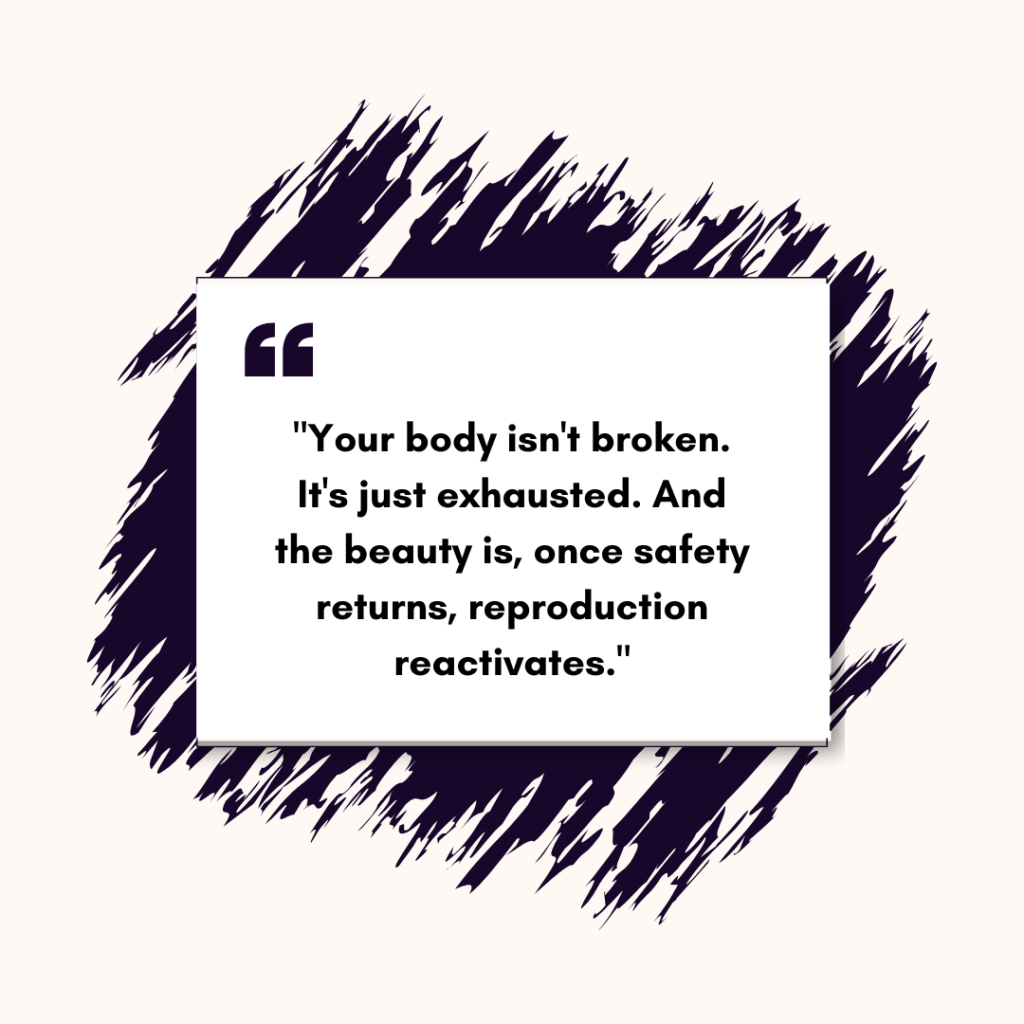Stress → Body’s Choice → Sacrificed Reproduction → The Illusion of Perimenopause


Paige Elizabeth
Founder and Coach
There’s a story women have been told for decades: that when their mood changes, sleep falters, or cycles become unpredictable, they must be “entering perimenopause.”

But that story is lazy science — and it’s keeping millions of women stuck in burnout, mistaking self-protection for decline.
The truth is that many women who believe they’re in perimenopause aren’t experiencing hormonal aging at all.
They’re experiencing a strategic shutdown — a body forced to preserve resources by sacrificing reproduction first.
This isn’t failure.
It’s physiology.
The Survival Hierarchy: How the Body Chooses What to Save
Your body doesn’t do random. Every symptom is a choice — a priority.
And the body’s first priority is always survival.
When the nervous system perceives a chronic threat — whether that’s emotional stress, under-eating, over-training, sleep deprivation, or unresolved trauma — it triggers an internal triage process.
Energy is diverted toward what’s essential: brain, heart, lungs, and blood sugar stability.
Everything else — digestion, reproduction, even hair and skin quality — is negotiable.
That’s the hierarchy.
And reproduction, as miraculous as it is, doesn’t make the cut.
Why Reproduction Is the First to Go
Reproduction is metabolically expensive.
It requires abundant energy, stable blood sugar, balanced hormones, and a sense of safety.
When you’re constantly in “fight-or-flight,” the body interprets that as now is not the time to create life.
So it does what it’s designed to do: it shuts down fertility to keep you alive.
Progesterone drops first, cycles shorten or disappear, and estrogen dominance develops.
You feel moody, hot, and ungrounded. You gain weight more easily. Sleep becomes light or restless.
You think: Is this perimenopause?
Your doctor may even agree.
But your ovaries aren’t failing — your nervous system is overwhelmed.
The illusion of perimenopause is the body’s intelligent attempt to protect you from burning out completely.
The Cortisol Steal: Hormonal Robbery in Real Time
Here’s what’s actually happening on a biochemical level.
All of your sex hormones — progesterone, estrogen, testosterone — begin as pregnenolone, known as the “mother hormone.”
Pregnenolone is made from cholesterol and is the raw material your body uses to create both cortisol (your stress hormone) and reproductive hormones.
When you’re under chronic stress, the body diverts pregnenolone away from reproductive hormones to make more cortisol — a process called pregnenolone steal.
The logic is simple:
Survival now, reproduction later.
This isn’t malfunction — it’s a brilliant reallocation of resources.
The problem is, most women never exit survival mode, so “later” never comes.
The result is a chronic pseudo-perimenopause where your body is acting fifty when you’re only thirty-eight.
The HPA Axis Breakdown
When the hypothalamus (in the brain) senses threat, it signals the pituitary gland to tell the adrenals: Make cortisol.
This is your HPA axis — hypothalamic-pituitary-adrenal communication — the command center for stress.
In short bursts, it’s protective.
But when activated for months or years, it burns through minerals, depletes B vitamins, suppresses progesterone, and eventually down-regulates your entire hormonal system.
That’s when your period becomes unpredictable, your energy tanks mid-day, and your body starts holding fat no matter what you eat.
This is why so many women’s labs come back with “normal” hormone levels — because the issue isn’t ovarian failure; it’s neural exhaustion. The messenger system itself has gone offline.
Why This Mimics Perimenopause
Here’s how stress-induced reproductive suppression looks identical to early menopause:
| Function | Stress Shutdown | True Perimenopause |
|---|---|---|
| Progesterone | Depleted from cortisol production | Naturally declines with age |
| Estrogen | Fluctuates, creating estrogen dominance | Gradual ovarian decline |
| Libido | Low from cortisol overload | Low from lower estrogen/testosterone |
| Sleep | Interrupted by adrenaline | Interrupted by hormonal shifts |
| Mood | Anxious, wired, or flat | Variable but usually less reactive |
| Reversibility | Yes | No |
Your body isn’t broken. It’s just exhausted.
And the beauty is, once safety returns, reproduction reactivates.
Reversing the Shutdown: Safety Before Strategy
Women love to fix things.
But the body doesn’t respond to strategies — it responds to signals.
If your body doesn’t feel safe, no supplement or hormone replacement will override that message.
Safety comes first. Always.
Here’s what that looks like in practice:
1. Eat Enough — Especially Fat and Protein
Food tells your body it’s safe. Under-eating is a threat signal.
Fat rebuilds hormones; protein rebuilds structure.
When you eat enough, your nervous system stops bracing for scarcity and begins repairing.
2. Sleep Is Hormone Therapy
One night of sleep deprivation raises cortisol and lowers progesterone.
Eight hours of consistent rest is more powerful than any biohack.
3. Boundaries as Medicine
Saying no is a biological event. It’s not “self-care” — it’s metabolic regulation.
Every time you suppress a no, your nervous system pays the bill.
4. Relearn Rest
Rest isn’t laziness; it’s progesterone in action.
Progesterone is the hormone of calm, repair, and receptivity.
When you rest, your body gets the message: We can create again.
5. Address Emotional Burnout
Unresolved resentment, guilt, or self-abandonment all mimic stress at the cellular level.
Healing isn’t just physical — it’s relational. It’s energetic.
When the Body Feels Safe, Hormones Heal Themselves
You don’t need to “boost hormones.”
You need to remove what’s blocking them — chronic stress, undernourishment, emotional suppression.
When women repair the stress signal, something remarkable happens:
Their cycles normalize.
Libido returns.
Sleep deepens.
Weight redistributes naturally.
Emotional resilience returns.
They feel young again — not because they reversed time, but because they stopped living against themselves.
The Illusion Dissolves
When the hypothalamus (in the brain) senses threat, it signals the pituitary gland to tell the adrenals: Make cortisol.
This is your HPA axis — hypothalamic-pituitary-adrenal communication — the command center for stress.
In short bursts, it’s protective.
But when activated for months or years, it burns through minerals, depletes B vitamins, suppresses progesterone, and eventually down-regulates your entire hormonal system.
That’s when your period becomes unpredictable, your energy tanks mid-day, and your body starts holding fat no matter what you eat.
This is why so many women’s labs come back with “normal” hormone levels — because the issue isn’t ovarian failure; it’s neural exhaustion. The messenger system itself has gone offline.
Stop Surviving, Start Thriving: Unlock Your Hormones' Full Potential.
This is exactly what we do in The Reset Program.
We rebuild the body’s sense of safety so hormones, mood, and metabolism can recover naturally.
Join the 90-day reset to experience what happens when your body stops surviving — and starts thriving again.
Ready to reverse the stress-induced shutdown and feel young again?
Book a call and Join The 90-Day Reset Program and Reclaim Your Vitality
